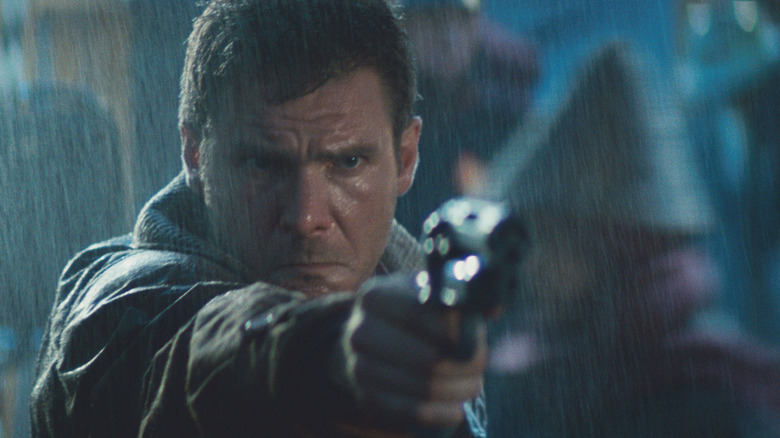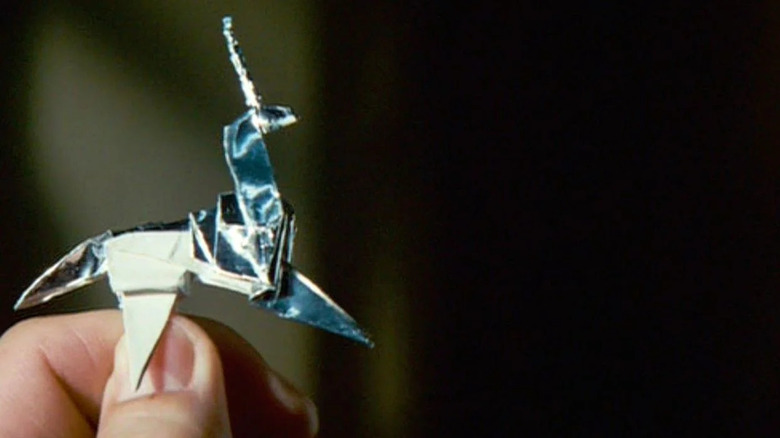Blade Runner's Big Unanswered Question Was Kept A Secret From Harrison Ford
By this point, it should be a given that any story centered around human-like robots will inevitably reveal that one of its main characters, believed to be a regular human, has actually been a robot the whole time. Ridley Scott's "Blade Runner," centered around androids called replicants, is no exception. The 1982 sci-fi film introduces us to Rachael (Sean Young) early on, only to reveal quickly afterward that she's a replicant. Not only that, but she's just starting to suspect she's not a real human. "Suspect?" Deckard (Harrison Ford) asks Rachael's creator. "How can it not know what it is?"
Turns out, the science behind replicants has advanced to the point where they can be installed with fake memories, making them believe they've lived a long, event-filled life. When Deckard explains this to Rachael later, proving his point by bringing up a memory Rachael's never told anyone about, she quietly cries and leaves the room, but not before throwing the fake photographs of her fake childhood on the floor. The idea that someone might not know they're a replicant, that something as solid as their own personal memories can't even be trusted, is something that raises another question for the audience: Is Deckard himself a replicant? He doesn't think he is, sure, but Rachael didn't think she was, either.
When it comes to this idea, however, Harrison Ford was not a fan. "I felt that the audience needed to have someone on screen that they could emotionally relate to as though they were a human being," he explained to Vanity Fair. Making Deckard a robot would, in his view, undercut that connection. But Ridley Scott had other ideas.
What it means to be human
According to Paul M. Sammon, a journalist who was on the set and later wrote "Future Noir":
"Without telling his star, [Ridley] Scott started inserting visual clues that Deckard was non-human. Midway through the film, Deckard has a drunken daydream of a unicorn galloping through a forest. In the last scene, he finds that Gaff, a fellow blade runner, has left an origami unicorn at his front door — a sign that his innermost thoughts were actually implanted. When they shot the scene, according to Sammon, [Harrison] Ford realized what was happening and yelled, 'Goddammit, I thought we said I wasn't a replicant!'"
Although it's understandable why Ford would find this storytelling decision annoying — over 30 years later, this kind of twist has certainly been run into the ground — the movie at least leaves enough wiggle room for audiences to conclude that Deckard's a normal human. The ambiguity raised by the origami unicorn serves as a pretty smart emphasis on the questions the film raises about what it really means to be human. Deckard spends the whole movie chasing down and killing a group of rogue replicants. The replicants, while often scary and violent, are ultimately treated as sympathetic figures. They may not be human by the textbook definition, but they certainly seem to feel genuine human emotions. They fear death like a real person would, and they long for companionship in much the same way.
By making it unclear if Deckard's a real person or not, the movie provides its strongest argument yet that whatever the differences between humans and replicants may be, it's not strong enough to justify treating them so callously. As the film ends with Deckard running away with Rachael to a start a new life, the film seems to argue that whether you're a "real" human or not doesn't really matter; you still deserve basic human dignity.

